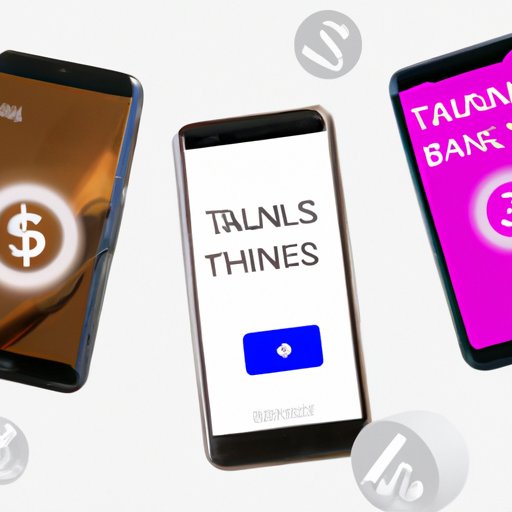
I. Introduction
Transferring money from bank to bank can be a common problem for many people. It can be a time-consuming process that involves a lot of paperwork, fees, and complicated procedures. Banks often charge high fees for transferring money, and their transaction times can be slow. Fortunately, there are several ways to transfer money from one bank account to another. In this article, we will explore different methods of transferring money, comparisons of popular third-party services, security tips, international transfers, real-life case studies, and alternative payment methods.
II. Step-by-Step Guide
The process of setting up an account for bank to bank transfers is simple. Most banks offer online banking services, which allows you to perform various transactions right from the comfort of your home. To get started, you’ll need to provide your personal information, including your name, address, social security number, and identification number.
Once your account is set up, you can link multiple bank accounts to it. Linking multiple bank accounts allows for easy transfers from one account to another. To link accounts, you’ll need to provide the account and routing numbers for each account.
Here is a step-by-step guide to transfer money from one bank to another:
- Log in to your online banking account.
- Select the transfer option.
- Choose the account you want to transfer the money from and the account you want to transfer the money to.
- Enter the amount you want to transfer.
- Confirm the details and submit your request.
III. Comparing Bank Transfer Services
Third-party transfer services like Zelle, Venmo, and PayPal are becoming more popular for transferring money from one bank account to another. These services allow for easy, instant money transfers without the need for complicated bank procedures. Here is a comparison of these popular bank transfer services:
Zelle
Zelle is a digital payment service that partners with over 100 banks and credit unions in the US. It allows users to transfer money between bank accounts using only an email address or phone number. Zelle offers a real-time transfer option, which means that the money will be available immediately in the recipient’s account. The service is free, but your bank may charge a fee for using Zelle.
Venmo
Venmo is a mobile payment service that lets users send and receive money from their mobile devices. Users can connect their bank accounts, debit cards, or credit cards to their Venmo account, and transfer money to friends or family. Venmo transfers are usually processed within one to three business days, and there is a 1% fee for using a credit card or non-major debit card.
PayPal
PayPal is a digital payment platform that allows users to send and receive online payments. It can be used to pay for goods and services online, or to transfer money between bank accounts. With PayPal, users can hold money in their account, and access it whenever they need it. PayPal transfers usually take one to three business days, and there are fees for certain transactions.
IV. Sharing Security Tips
When transferring money from bank to bank, it’s important to keep your bank account information safe. Here are some tips for keeping your account secure:
- Keep your login credentials, passwords, and PINs secure and confidential. Use strong passwords and update them regularly.
- Avoid using public Wi-Fi or unsecured networks when performing bank transactions.
- Regularly check your bank account statements and report any suspicious transactions.
- Only use reputable third-party services for transferring money.
It is also important to be aware of scams and fraud attempts. Scammers may try to trick you into giving them your bank account details, so it is essential to be cautious when receiving messages or calls from strangers.
V. Highlighting International Transfers
Transferring money across international borders can be a more complicated process with additional fees, exchange rates, and taxes to consider. It’s important to understand the different factors that may impact international bank transfers. Banks can provide information on conversion rates and fees for international transfers. Alternatively, third-party services like TransferWise or WorldRemit can be used for international transfers with lower fees and greater convenience.
VI. Real-Life Case Studies
Real-life examples can help highlight the challenges involved in transferring money from bank to bank. One example is a student who needs to transfer money from their US bank account to their university account in the UK. They need to make sure they understand the extra fees and charges involved for international transfers. Alternatively, a small business owner might need to transfer money between their business and personal bank accounts. They need to ensure they use a trusted third-party service like PayPal or Zelle to prevent fraudulent activity on their accounts.
VII. Alternative Payment Methods
Aside from traditional bank transfers, alternative payment methods can be used for transferring money from bank to bank. These methods include cryptocurrencies like Bitcoin or prepaid debit cards like Visa or Mastercard. Cryptocurrencies can be used for global transactions with total security, privacy, and low fees, while prepaid debit cards can avoid the need for a traditional bank account and can be used for online or offline transactions.
VIII. Conclusion
Transferring money from bank to bank can be a tricky process, but it doesn’t have to be. By exploring different approaches, comparing bank transfer services, sharing security tips, highlighting international transfers and alternative payment methods, and discussing real-life examples and unique situations, you can choose the best option for your needs and preferences. Always stay vigilant about the security of your information and accounts, and take the necessary precautions to ensure safe and convenient money transfers.





